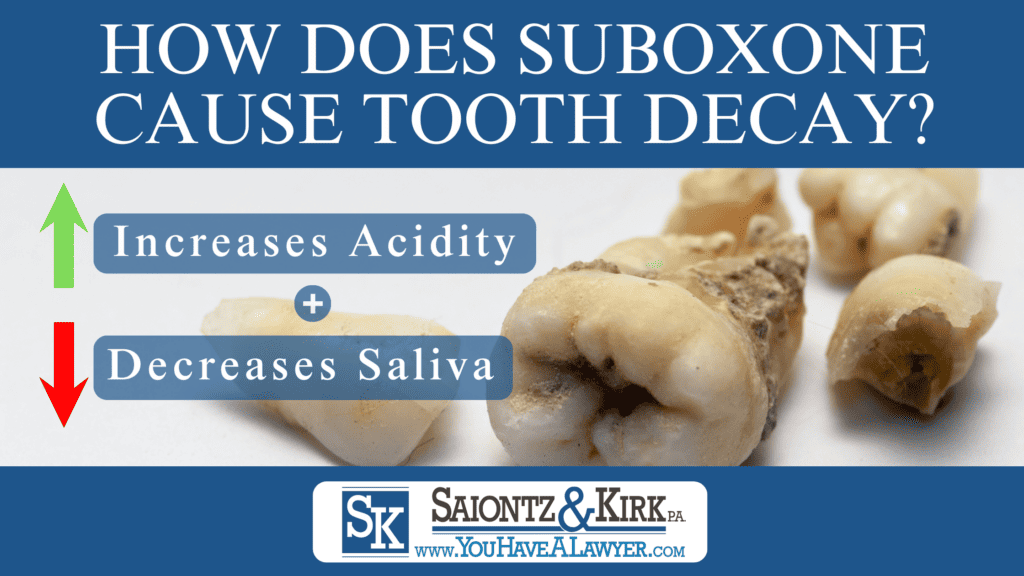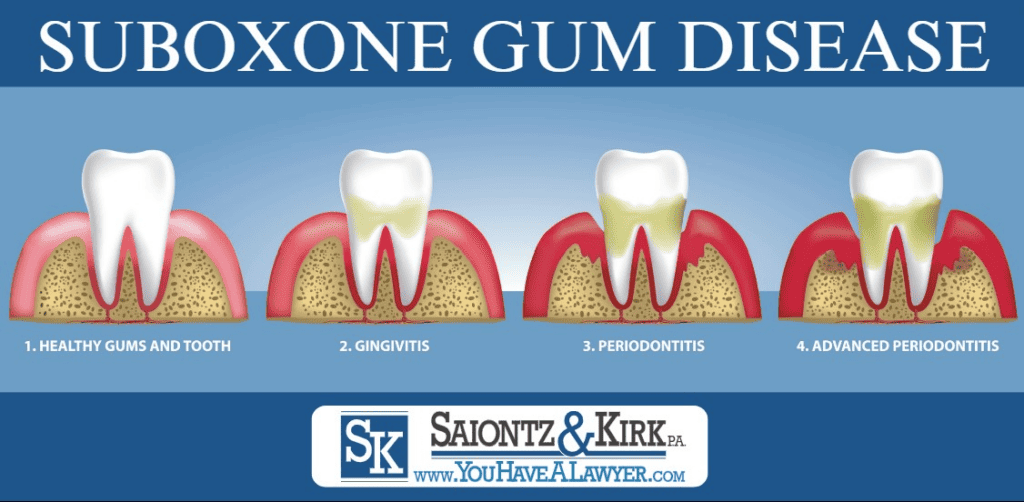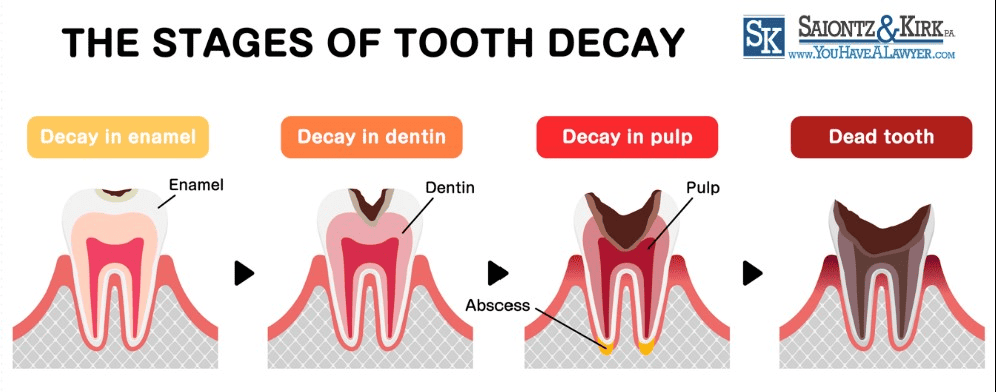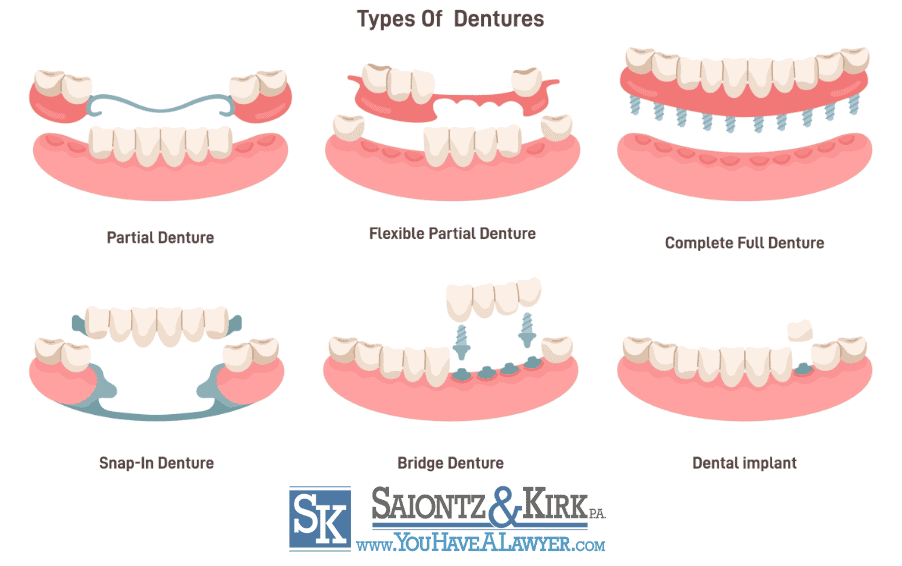How Does Suboxone Cause Dental Side Effects?
Suboxone increases tooth decay risks due to its acidic nature and side effects that cause dry mouth, a condition known as Xerostomia. The acidic nature of Suboxone and its ability to inhibit saliva production can directly erode and weaken tooth enamel, making it more susceptible to decay.
Although the drug makers knew or should have known about the risk that Suboxone causes dental damage, information and warnings were withheld from users and the medical community for years. It was not until June 2022 that these Suboxone side effects were added to the drug warning label, which came too late for many individuals.
As a result of the decision to place a desire for profits before patient safety, the lawyers at Saiontz & Kirk, P.A. are pursuing Suboxone tooth decay lawsuits for individuals throughout the United States.

This page outlines the growing evidence that explains how Suboxone causes dental side effects, and how former users could have avoided permanent damage to their teeth if they had been advised to schedule regular dental checkups and establish a tooth decay prevention plan.
Info About Suboxone Dental Side Effects On This Page
Suboxone Acidic Ingredients Impact on Dental Health
How Saliva Reduction From Suboxone Causes Dental Issues
What Dental Problems Are Linked to Suboxone?
Studies Linking Suboxone to Dental Problems
Suboxone Tooth Loss Warning
Dental Procedures to Fix Suboxone Tooth Decay
What to do if you suffered tooth decay after using Suboxone
Suboxone Acidic Ingredients Impact on Dental Health
Suboxone was first introduced in 2002, involving a tablet or pill. However, that version was replaced with a sublingual film in late 2010, and the ingredients in Suboxone film are key to understanding why the drug has a major impact on dental health.
Suboxone sublingual film was intentionally designed to be acidic to allow the active ingredients, buprenorphine and naloxone, to be more efficiently absorbed into the bloodstream. This is why a user who places a Suboxone sublingual film in their mouth may recognize a slightly sour or tangy taste. This taste is a direct indicator of the film’s acidic ingredients to decrease the pH levels in the drug’s surroundings.
For clarity, pH is a scale used to determine the acidity or alkalinity of a substance. The scale ranges from 0 to 14, with 7 being neutral. Values below 7 indicate acidity, while those above 7 denote alkalinity. Envision a balanced see-saw: leaning to the left (values below 7) signifies an acidic condition, whereas tilting to the right (values above 7) points to an alkaline condition.
Acidic Ingredients Added to Suboxone
To achieve this acidic environment, the manufacturer adds ingredients to Suboxone that intentionally lower the natural pH levels in the mouth to increase acidity. According to the Suboxone Sublingual Film Prescribing Information, the drug contains the following acidic ingredients;
- Citric Acid: This ingredient is used in foods and pharmaceuticals as an acidifying agent, and for its tangy flavor.
- Sodium Citrate Dihydrate: This is the sodium salt of citric acid and acts as a buffer. While citric acid is acidic, sodium citrate is more alkaline. When both are present in a formula, they can help control and stabilize the pH, potentially creating a buffer system.
- Acesulfame Potassium: This is an artificial sweetener and isn’t primarily acidic. However, it can have an effect on mouth pH indirectly due to its interactions with oral bacteria.
- Lime Flavour: Natural limes are acidic, primarily because of their citric acid content. Depending on the nature and composition of the flavoring agent, it might contribute some acidity, especially if it contains components derived from the actual fruits.
The side effects of Suboxone’s acidic ingredients contribute to a reduction in saliva in the mouth, which acts as an important protection for dental health.
How Saliva Reduction From Suboxone Causes Dental Issues
Medical research has directly linked Suboxone to dry mouth, a condition where the salivary glands do not produce sufficient saliva. Saliva plays a vital role in maintaining oral health, aiding in digestion, and providing lubrication. It contains enzymes, proteins, and minerals that help neutralize acids and support the remineralization of tooth enamel.
Why does Suboxone cause dry mouth?
Suboxone causes dry mouth due a combination of its main active ingredient buprenorphine and the acidic ingredients added to the drug.
Buprenorphine interacts with the central nervous system and can affect the autonomic nervous system’s function, which controls salivation among other bodily processes. When the autonomic nervous system’s balance is disrupted, it can result in reduced saliva production, leading to the sensation of a dry mouth.
What are the dental side effects of dry mouth caused by Suboxone?
Dry mouth from Suboxone can diminish these natural defenses, allowing bacteria to thrive, which can over time increase the risk of;
- Gingivitis: The initial stage of gum disease marked by gum inflammation and occasional bleeding due to plaque at the gumline. Damage is reversible at this point as bone and connective tissues remain unaffected.
- Periodontitis: Here, supporting bone and fibers for teeth are permanently harmed. Pockets form below the gumline, trapping food and plaque. Timely dental intervention can mitigate further damage.
- Advanced Periodontitis: The final stage where teeth-supporting fibers and bone are lost, leading to shifting or loose teeth that may require removal.

What Dental Problems Are Linked to Suboxone?
Suboxone dental decay lawsuits filed throughout the United States outline a growing number of studies and case reports submitted to by users, which suggest a strong link between Suboxone and dental problems.
Lawsuits claim the acidic nature of Suboxone sublingual films combined with the reduction in salivary gland production can lead to advanced stages of tooth decay and other dental problems, which could have been avoided if warnings about these risks had been provided.
Enamel Erosion
Acidity from Suboxone can weaken and erode the tooth’s protective enamel layer. This erosion, compounded by a lack of protective saliva, makes teeth more susceptible to damage from external agents.
Dentin Exposure
Dry mouth, intensified by Suboxone, accelerates enamel wear. This leads to the exposure of the underlying dentin, which can cause heightened sensitivity and predispose teeth to other issues.
Gum Recession
Suboxone’s acidity can irritate and damage gum tissues. When combined with dry mouth effects, this irritation can cause the gums to recede and expose more of the tooth structure.
Cavities
An acidic environment, enhanced by Suboxone, can foster the growth of cavity-causing bacteria. The diminished salivary defense further aids these bacteria in cavity formation. This is why many users experience cavities from Suboxone directly near where they typically place the film in their mouth.
Cracked Teeth
Acidity-induced erosion can compromise the structural integrity of teeth. The concurrent dry mouth condition makes them more prone to cracks or fractures.
Root Decay
Insufficient saliva can lead to increased exposure and vulnerability of the tooth roots. As a result, these roots are more susceptible to decay.
Tooth Abscess
Reduced saliva production can elevate the risk of bacteria infiltrating the tooth. This bacterial invasion can cause an abscess or a pocket of pus to form.
Tooth Loss
The acidic nature of Suboxone contributes to continued enamel erosion. Coupled with dry mouth, untreated dental issues can escalate, leading to tooth loss.

Studies Linking Suboxone to Dental Problems
Growing medical evidence has established a strong link between Suboxone sublingual films and dental problems. In several published studies, researchers have found that frequent exposure to the acidic ingredients in Suboxone may significantly increase the risk of tooth decay.
Dental Decay Within 18 Months of Starting Suboxone
In a September 2012 study published in the American Journal of Addiction titled Buprenorphine/naloxone and dental caries: a case report researchers from Harvard Medical School described a potential link between Suboxone and rapid dental deterioration.
Researchers reviewed a case involving an individual using Suboxone to treat opioid use disorder, who experienced a sudden and rapid decline in oral health. The drug was initially prescribed as a remedy for opioid dependence after using oxycodone for back pain. However, researchers found that the individual’s oral health declined within 18 months of starting Suboxone. This decline led to the necessity of endodontic procedures to treat severe decay in multiple teeth.
The study found the deterioration occurred in the absence of any changes in the patient’s dental hygiene or sugary food and beverage intake. The authors concluded the report by expressing concerns about the potential dental side effects after use of sublingual buprenorphine/naloxone.
Suboxone Linked to Increased Risk of Cracked Teeth and Tooth Extractions
In a 2013 study published in the medical journal Primary Care Companion CNS Disorders researchers from Brigham and Women’s Hospital in Boston reviewed data on patients with opioid dependence that experienced worsening dental health after initiation of buprenorphine.
Researchers found that after starting buprenorphine treatment, there was an increased risk of developing dental caries, dental fillings, cracked teeth, crown replacements, root canals, and tooth extractions. At the time of the assessment, 54.5% of individuals reported having toothache pain.
Suboxone Tooth Loss Warning
Since Suboxone film was introduced, there have been a substantial number of adverse event reports submitted to the FDA involving dental issues following the use of Suboxone.
In January 2022, the FDA issued a Suboxone tooth decay warning, after identifying over 300 reports of severe dental adverse events after using buprenorphine medicine.
Most of these reports about dental problems from buprenorphine medicines dissolved in the mouth were from individuals in their 40s. However, there were cases involving people as young as 18. Some accounts even suggested dental harm from Suboxone within just two weeks of starting the treatment.
Since the warning update, the FDA and the Mental Health Services Administration now both encourage anyone who has developed dental side effects or other side effects after using Suboxone to report the events to the FDA’s MedWatch program.
Users are now provided a series of recommendations for steps that should be taken to reduce the risk of serious dental problems from Suboxone, including:
- Take a large sip of water after Suboxone film is completely dissolved, swishing it around the teeth and gum.
- Wait at least 1 hour after using Suboxone film before brushing your teeth, to avoid damage to your teeth and allow the mouth to return to its natural state.
Suboxone Tooth Extraction Reports
Listed within the growing number of reports submitted to the FDA Adverse Event Reporting System (FAERS) includes a number of incidents involving individuals who required tooth extractions while using Suboxone.
- Case Report #21333802: A 34 year old female who reported taking Suboxone sublingual films experienced multiple dental caries requiring tooth extraction(s) in August 2022. The FDA marked this report as a serious event.
- Case Report #21333802: A 31 year old male reported using Suboxone and suffered tooth decay requiring dental surgery to extract several teeth in November 2021. The FDA marked this report as a serious event.
Dental Procedures to Fix Suboxone Tooth Decay
Although the manufacturer agreed to update the Suboxone warning following the FDA warning in 2022, many individuals who have used Suboxone to treat opioid withdrawal symptoms for years prior to the warning have been left with severe tooth decay, oral infections and other dental problems requiring painful and extensive dental procedures; including;
Dental Fillings
In the preliminary stages of decay caused by Suboxone, dental fillings serve as an effective repair mechanism. However, with the passage of time, these fillings might deteriorate, chip, or even get encircled by fresh decay, necessitating further dental interventions.
Tooth Extraction
In situations where teeth are profoundly affected by Suboxone-induced decay, extraction emerges as the sole feasible solution. While this measure is indispensable, it may introduce lasting consequences like bite alignment shifts. Subsequent to an extraction, it becomes imperative to consider tooth replacement strategies such as dental implants or dentures, which may call for intermittent realignments or replacements over time.
Dental Crowns
When teeth undergo decay due to Suboxone, dental crowns provide a potent shield. With time, these crowns might undergo wear, potentially leading to the need for replacements. Additionally, having a crown may amplify the tooth’s susceptibility to issues like gum recession, thereby influencing the well-being of adjacent tissues.
Root Canal Therapy
Severe decay induced by Suboxone can occasionally be treated with root canal therapy, a process that conserves the impacted tooth. After this therapy, the tooth might become brittle, frequently requiring the safeguard of a dental crown. There’s a risk of reinfections or other complications, warranting added procedures.
Dental Bridges
For cases where Suboxone-induced decay results in tooth loss, dental bridges offer a sustainable solution. The lifespan of these bridges is contingent on the health of the supporting teeth. Any harm to these anchor teeth or the bridge itself might necessitate additional dental treatments.
Dental Implants
Serving as a foundation for a replacement tooth or crown, a dental implant is a titanium fixture surgically embedded into the jawbone to supplant the root of a decayed or absent tooth. As time progresses, issues such as implant failures, infections, or bone diminishment might arise, potentially requiring further surgical interventions or maintenance.
Dentures
In response to multiple teeth lost due to the detrimental effects of Suboxone, dentures present both comprehensive and partial replacements. Over time, structural alterations in the oral cavity or wear of the dentures might call for modifications. Regular assessments are crucial to ensure the dentures’ optimal fit and functionality.

What to do if you suffered tooth decay after using Suboxone
If you or a loved one have experienced tooth decay or dental problems after using Suboxone, you should contact our Suboxone tooth decay lawyers for a completely free consultation to answer any questions you may have and explain your legal rights.
For more than a decade, Indivior Inc. and its subsidiaries have advertised Suboxone buprenorphine medicines as a safe treatment for opioid use disorder, while failing to disclose the risks of severe dental injuries or warning individuals to schedule regular dental checkups to monitor for tooth decay.
